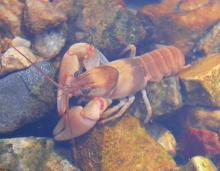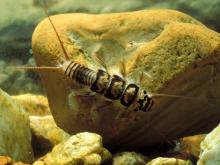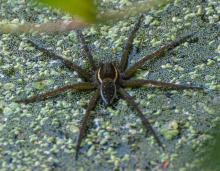Aquatic Invertebrates
Media

Species Types
Scientific Name
Faxonius luteus (formerly Orconectes luteus)
Description
The golden crayfish varies in color from olive green to golden yellow. Many body parts are trimmed with red. A dark band crosses the head just in front of the cervical groove, and another crosses the carapace at its junction with the abdomen. It's a wide-ranging species.
Media

Species Types
Scientific Name
Faxonius longidigitus (formerly Orconectes longidigitus)
Description
The longpincered crayfish is large and colorful, with very long, slender, blue-green pincers that are studded with prominent yellowish knobs. It is restricted to the White River basin in the Ozarks.
Media

Species Types
Scientific Name
Bivalve molluscs in order Unionoida
Description
Secretive and seldom seen, freshwater mussels are extraordinarily diverse in Missouri. We have nearly 70 species within our borders. Many are declining, and several are endangered.
Media

Species Types
Scientific Name
Gyraulus, Helisoma, Menetus, Micromenetus, Planorbula spp.
Description
Ramshorn snails are easy to identify at a glance, because the shell is a flat, disklike coil. Like other pulmonate aquatic snails, they lack the hard horny “trapdoor” possessed by other types of aquatic snails.
Species Types
Scientific Name
Various species in the genus Hydra
Description
We’ve all seen aquariums and pictures of tropical saltwater invertebrates such as corals, jellyfish and anemones—but did you know that there are similar creatures living in the freshwater habitats of Missouri?
Media

Species Types
Scientific Name
Freshwater species in the phylum Bryozoa
Description
Bryozoans are tiny, filter-feeding invertebrates. They create colonies that can be mossy, branching, or round and jellylike.
Media

Species Types
Scientific Name
There are hundreds of species in North America
Description
Stonefly larvae are aquatic and somewhat resemble the larvae of mayflies and damselflies. Their presence usually indicates good water quality.
Media

Species Types
Scientific Name
Dolomedes spp., Tetragnatha spp., and others
Description
A variety of spiders are adapted for live on and around water. Many of these are called fishing spiders. Several have the ability to run across the water’s surface. Some build webs, others do not.
Media

Species Types
Scientific Name
Dugesia, Planaria, and other genera
Description
Unlike their parasitic cousins in the flatworm group, turbellarians, or planarians, are tiny carnivores or detritus-eaters that glide smoothly across submerged leaves and other objects.
Media

Species Types
Scientific Name
Corbicula fluminea
Description
The Asian clam is a nonnative, invasive species that lives in a variety of aquatic habitats. It has thick shells with distinctly ridged, concentric rings and a yellowish-brown to dark brown shell covering.
See Also
About Aquatic Invertebrates in Missouri
Missouri's streams, lakes, and other aquatic habitats hold thousands of kinds of invertebrates — worms, freshwater mussels, snails, crayfish, insects, and other animals without backbones. These creatures are vital links in the aquatic food chain, and their presence and numbers tell us a lot about water quality.





















